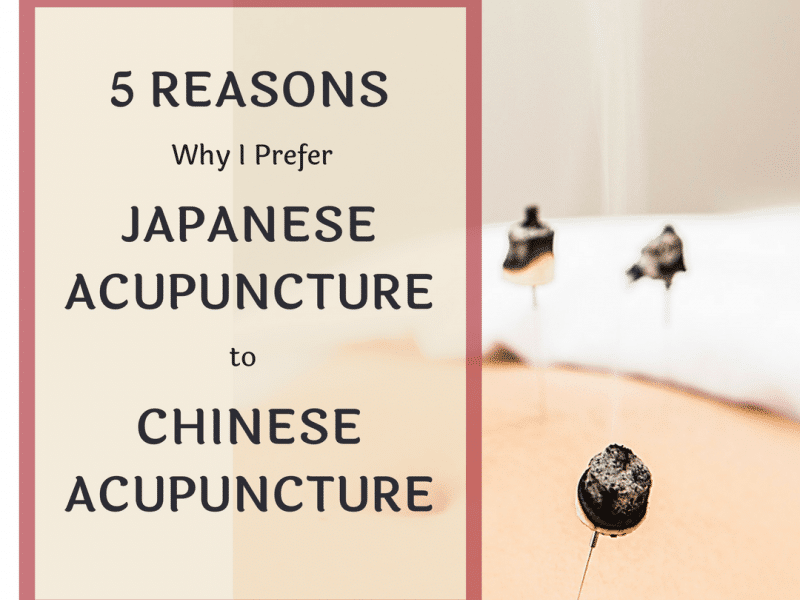Why I Prefer Japanese Acupuncture
I was recently asked by one of my students to write about why Japanese acupuncture is better than Chinese acupuncture.
Of course there is no such thing as better, yet like many western practitioners practicing acupuncture I, too, practiced Chinese style acupuncture before transitioning to Japanese style. Therefore, I wish to share with you why I enjoy doing acupuncture Japanese style.
I write ‘enjoy doing’ because, the way I see things, this is by far the most important aspect of any career – enjoying what we do.
1 No Pain
In my early years I was a devoted practitioner of the De-Qi school, or some might call it the “no pain – no gain school of thought”. I felt that it was absolutely necessary that the patient feel the De-Qi. I felt that the stronger the stimulation, the more powerful the treatment. My wife, who is still my loyal patient, remembers those De Qi days . Well, needless to say, today, after some 20 years of practice, I am saying the opposite. In most cases, not all, but a huge percentage, very light stimulation can produce profound effects on different body systems and pain relief. This is just wonderful. First, it is very rewarding to switch off pain or different internal symptoms with light minimal stimulation. Second, since using Japanese style acupuncture, I see many more patients. All those delicate or nervous or young ones can calmly lie on my treatment table without worrying that treatment might be too painful or too intense. Last, I find myself apologizing much less during treatment, “Oh I’m sorry – was that too painful?” or “This might be painful- sorry…” OUCH!
2 Palpation Diagnosis
In Nei Jing Chapter 16 the authors speak of palpation pressure points in the abdomen in correlation to body constitution, emotional state and ailments. This is a great and simplified text upon which much of the abdominal diagnosis theory was built. Yet, palpation skills were never emphasized in Chinese medical history as were tongue diagnosis, pulse diagnosis and symptomatology. Perhaps this is due to cultural influences where touch and palpation in the treatment room were not accepted in ancient China. On the other hand, in Japan, and especially 16 century Japan, the government made acupuncture a skill for the blind. Thus palpation became a main diagnostic tool and art. I cannot imagine myself today treating and diagnosing patients without palpation. The amount of information derived by palpation is endless. Throughout the years, Japanese practitioners have brought palpation diagnosis to a high level skill and art while integrating ancient traditional texts together with modern scientific and functional medicine.
3 Where East meets West
Japan always integrated the traditional and classical texts, together with modern science and medicine. Master Osamu Ito, was an osteopath, physiotherapy doctor, and an acupuncturist. He developed amazing techniques using polarity elements, such as magnets, and the use of the extraordinary vessels to treat skeletal and structural imbalances. Sensei Kiiko Matsumoto, my teacher, is one of the first and one of the most influential Japanese acupuncture practitioners who introduced this body of knowledge to the west, and remarkably integrated traditional concepts and treatment with modern day medicine.
4 Moxa! I love Moxa
Though not solely a Japanese treatment therapy, this ancient Chinese therapy, not widely taught in TCM schools, was further investigated, integrated, and made into a true therapy and art thanks to great Masters such as Master Fukaya, and Master Sawada. Moxa has the most amazing therapeutic effect, and is a true and unique art and mastery.
5 Decision making
Decision making in the clinic can be very difficult and, at times, frustrating . I saw this many times with students when I worked as a clinical supervisor in acupuncture schools. You might THINK or ASSUME that your diagnosis is correct but you really have no signs that you made the right choice of points. Before working in Acupuncture – Japanese Style, I found myself just HOPING until the next treatment, that my choice of points and strategy was correct. This is less true for pain issues where you expect to see improvement during treatment itself. Yet, for the more complex and internal issues, palpation diagnosis acts like a compass, telling me during treatment time whether my treatment is correct and influencing the different systems that must be addressed. Furthermore, through palpation diagnosis I can assess whether my point location and choice of points is correct. This is a BIG deal. This lets me know how I am doing on real time. Bottom line, because of palpation diagnosis I am much more relaxed during treatment, and the whole process of work is ENJOYABLE and INTERESTING. My patients wondrously become my teachers and they also take part of the healing process since they are part of this process. Palpation diagnosis makes the patients aware of these palpatory pressure pain areas. TRUST is gained during treatment and with the practitioner since the patient actually feels how these pressure pain areas diminish together with their symptoms.
If you find this interesting, continue following me, as I will explain in much, much more detail and depth, through blog writings or video seminars, the wonders of Acupuncture – Japanese Style

